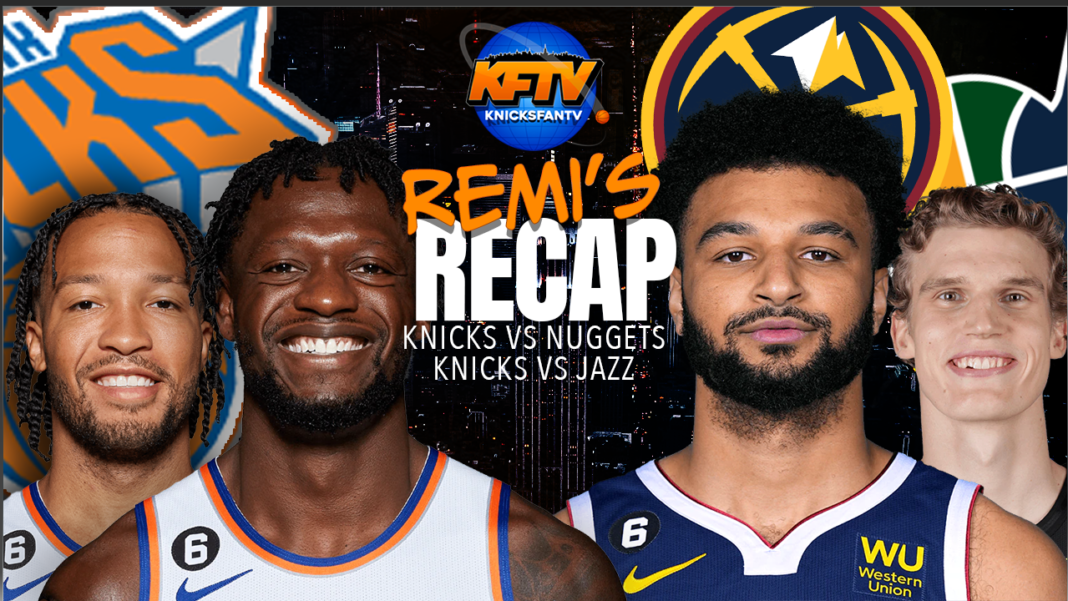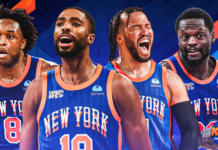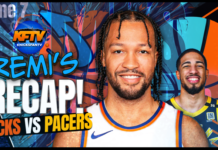The New York Knicks defeated the Utah Jazz and Denver Nuggets on a back-to-back. A team dinner and shorter rotation may have done the trick.
Make sure to catch the whole Knicks Fan TV Postgame show on all major podcast platforms below:
• Spotify
• Apple Podcasts
• Google Podcasts
• Stitcher
The New York Knicks won back-to-back road games against two of the best teams out West. The players had a team meeting and dinner prior to the wins, and we saw changes in the players and Tom Thibodeau. The new approaches led to great results!
Thibodeau shortened the rotation, which helped players settle into their roles and produce. Meanwhile, the players showed more intensity on defense with active hands and much better on-ball pressure. Everyone seemed dedicated to passing defensive rebounds up the floor, which sparked a fast pace that sparked easy offense for everyone.
There was no quit in this team. We’ve seen them look listless in the past as their leads eroded or opponents ran away with games. But the Knicks entered both fourth quarters on the road with deficits, and they overcame both with a more formidable defense than we’ve seen all season. For the first time in a long time, they looked like a Tom Thibodeau team.
Let’s look at both games and combine the performances for ratings reflecting two nights’ success.
The Knicks’ starters set the tone and overcame some illness
Jalen Brunson: 25 PTS (10/20 FG, 1/4 3PT, 4/4 FT), 8 AST, 3 REB, 3 STL, 4 TO in 34 mins against the Jazz
21 PTS (7/13 FG, 2/4 3PT, 5/5 FT), 7 AST, 5 REB, 1 TO in 31 mins against the Nuggets
Most Knicks had mixed results in the pair of games this week. However, that’s not true for Jalen Brunson. He started slowly against Utah but settled into the same sort of dominance that he showed in last year’s playoffs. Brunson ate them alive inside and was excellent as a playmaker. His turnovers were the only blemish, and most came early before he tightened things up.
Brunson nearly matched his efficacy in the next game with Denver. He shot less but more efficiently, thanks to a pair of threes. His playmaking was still displayed, and he didn’t turn the ball over. My only complaint in this one is that his defense wasn’t as aggressive, but he was still respectable.
I’m not sure Knicks fans are giving Brunson enough credit. Brunson’s averaging 20, 7, and 3.5 while shooting 49 percent from the field over the first 14 games of the season. His performance in the back-to-back was fantastic, but it’s also who he has been for most of his Knicks career so far. Other players step up or have off nights, but Brunson is consistently great and deserves more hype.
Brunson gets a 4.5 out of 5 for playing a pivotal role in closing both games against tough road opponents and for efficient scoring.
RJ Barrett: 18 PTS (5/18 FG, 0/5 3PT, 8/14 FT), 4 AST, 3 REB, 1 TO in 37 mins against the Jazz
11 PTS (4/18 FG, 0/9 3PT, 3/4 FT), 2 AST, 3 REB, 1 STL, 1 TO in 31 mins
RJ Barrett played despite being sick. He labored through his minutes, which made his huge dose of minutes and touches a head-scratcher. He attacked the basket against Utah, which helped him get to the free-throw line despite his futility everywhere else. But he settled for jumpers throughout most of the game in Denver, which further deteriorated his impact.
Barrett’s illness didn’t just take away from his play on the offensive end. He scraped by in Utah but was targeted by the Nuggets for most of the second night. Even when Barrett played up on shooters, he couldn’t prevent them from scoring.
I’ll give Barrett credit for toughing out his minutes out. But he didn’t need to play since he was in such bad shape. The Knicks have wings waiting for opportunities off the bench, and RJ didn’t have his legs. So it’s bizarre that Tom Thibodeau played Barrett a team-leading 37 minutes on night one, then 20 minutes in the first half of game two.
Barrett gets a 1 out of 5 for earning a ton of free throws and making a few nice passes despite his struggles.
Cam Reddish: 19 PTS (7/13 FG, 2/5 3PT, 3/3 FT), 1 AST, 1 REB, 1 STL, 1 BLK, 2 TO in 33 mins against the Jazz
10 PTS (3/5 FG, 0/1 3PT, 4/5 FT), 3 REB, 2 STL, 1 BLK in 36 mins against the Nuggets
Cam Reddish played arguably his best game of the season against Utah. That’s because he had an outsized defensive impact complemented by an aggressive effort on offense. He wasn’t as forceful with Denver, but he made great use of his touches. Cam used his length and finesse around the basket to continually finish in both performances.
But defense is the real story for Cam over these past two games. He wasn’t perfect against Utah but often made up for mistakes with sheer effort and athleticism. Reddish was even better guarding Michael Porter Jr and the Nuggets. His presence in the passing lanes didn’t just create steals; it also forced passers to work around his reach. That meant shooters caught the ball off-center and outside of their sweet spot. It’s much harder to hit shots when you have to reset your hands first!
It’s beginning to feel like Reddish has found his comfort zone with the Knicks’ starters. He’s found a niche by playing active defense, and teammates are beginning to find him on offense. But two games don’t equate to consistency. Cam has to keep this focus and energy up, and he’s on his way to a long-term critical role.
Cam picks up a 4 out of 5 for his impact rating. With a little more production in the assist and rebound columns, he’d be in the 4.5 to 5 range.
Julius Randle: 15 PTS (5/11 FG, 2/6 3PT, 3/3 FT), 1 AST, 5 REB, 1 BLK, 4 TO in 31 mins against the Jazz
34 PTS (11/21 FG, 3/10 3PT, 9/13 FT), 4 AST, 11 REB, 4 STL, 3 TO in 32 mins against the Nuggets
Julius Randle struggled with Utah, but there were signs that he wanted to change his style. Randle didn’t force many shots, and some of his turnovers looked like the result of trying to make faster decisions. He even passed his defensive rebounds up the court for quicker offensive possessions. But he struggled defensively, and the team played better during Obi’s minutes.
Randle didn’t let frustration take over. His faster decision-making and approach led to decisive, rhythm jumpers against the Nuggets a night later. Randle established his jump shot and then feasted on Denver’s lackadaisical rim protection. But this became his best performance of the season because of his defensive play, which included several hustle plays during a close fourth quarter.
Randle was the difference against the Nuggets. He kept the Knicks within reach from the start when no one else had it going. Then the big man dominated crunch time with his defense just as much as his offense. That’s the kind of effort that endeared him to the fans two years ago, and it can turn him into a winning player again if he keeps it up.
Randle gets a 3.5 out of 5 for his impact in the back-to-back combined. He’d get a 4.5 for his Nuggets effort, though, and I think we saw signs that this was coming even during a tough night in Utah.
Isaiah Hartenstein: 2 PTS (1/4 FG, 0/1 3PT), 1 AST, 9 REB, 1 STL, 1 BLK in 22 mins against the Jazz
0 PTS (0/1 FG), 3 REB, 1 STL, 1 BLK in 22 mins against the Nuggets
Isaiah Hartenstein struggled through two rough nights in a row. He never found his offense, finishing 44 minutes of play with just 2 points on five attempts. To his credit, Hart didn’t pick up any offensive fouls or turnovers. But that’s all I’ve got for his offensive contributions.
Defense and effort typically keep Hartenstein afloat, even when he struggles offensively. Not in these games. Hartenstein ran into early foul trouble with Utah and failed to make a mark on the boards against Denver. He still challenged shots and created loose balls, but the big man’s foot speed was an issue.
I won’t belabor the point. Hartenstein had a brutal couple of performances. His impact was limited. He was outperformed by Jericho Sims handily. Hart gets a 0.5 out of 5 for lack of production and impact.
New York’s second unit does well, but not enough to cover for others
Derrick Rose: 6 PTS (3/6 FG, 0/1 3PT), 3 AST, 1 TO in 14 mins against the Jazz
13 PTS (5/10 FG, 2/3 3PT, 1/1 FT), 3 AST, 1 REB, 1 BLK in 17 mins against the Nuggets
Derrick Rose moved better during both games of this combo. He looked sharp against Utah, with his vision on display as much as his ability to attack off the dribble. But IQ had the hot hand, which tempered Rose’s production.
The former MVP showed even more signs of life against Denver. His jump shot finally started to fall, and he was still aggressive in attacking the lanes. That led to thirteen points and three assists in less than 20 minutes. Again, he was a burst of energy and scoring in a close game.
I’ve been holding out hope that Rose’s early struggles resulted from recovering after a long layoff, and these past few games have given me hope that his legs are back. He’s shot 50 percent from the field in the last three games and played over 15 minutes in three of the past four. That might seem small, but he’d only broken that 15-minute mark in two of the first eleven games.
Rose picks up a 3 out of 5 for impact, with his six assists bumping a 2.5 performance up a notch. He’s starting to attack more, and the results are promising.
Immanuel Quickley: 13 PTS (5/10 FG, 3/6 3PT), 2 AST, 3 REB, 4 STL in 26 mins against the Jazz
6 PTS (2/5 FG, 0/2 3PT, 2/3 FT), 6 AST, 5 REB, 1 STL, 1 TO in 27 mins against the Nuggets
Immanuel Quickley found his scoring touch, including the jumper, against Utah. He exploded in the fourth quarter, sparking New York’s comeback along with Obi Toppin. But that didn’t stop IQ from finding teammates or playing pesky defense that led to four steals. He was crucial to the victory.
I’m intrigued that Quickley attacked the Nuggets with his playmaking. He didn’t chase shot attempts despite his success the night before. Instead, IQ sought his teammates and set them up with lovely passes. There was even an odd spell where he’d set up mismatches, and two players fumbled easy passes. Quick kept on passing up his looks for better ones anyway.
It’s almost as if Quickley and Rose traded roles in the two games. Their scoring flipped, and their focus on shooting or playmaking seemed to trade places. IQ also set himself apart with defense in this series, including the game-ending defensive stand against Jamal Murray.
IQ puts up a 3.5 out of 5 for great perimeter defense to go with quality offense.
Obi Toppin: 9 PTS (3/4 FG, 3/4 3PT), 4 AST, 6 REB in 18 mins against the Jazz
7 PTS (3/8 FG, 1/5 3PT), 3 REB, 1 TO in 23 mins against the Nuggets
Obi Toppin dominated most of his minutes against Utah. He knocked down jumpers, created for teammates, and grabbed big fourth-quarter rebounds. He and IQ were the catalysts of New York’s fourth-quarter momentum in that game. Obi didn’t have his jumper against Denver, though a couple of attempts came at the end of the shot clock. Toppin’s most significant impact on night two came as he provided space in a small-ball line-up next to Randle.
Toppin’s defensive play continues to be a mixed bag, but he wasn’t bad in either performance. Unfortunately, the second game saw him miss some box outs that led to worse results on the boards. I’d like to see at least one stock in forty minutes of action from the big man. But he worked hard enough to warrant a pass for lack of defensive numbers.
Oddly enough, Toppin deserved more minutes in the first game than the second. But he was on the floor for New York’s best stretches in both games. He’s been a net positive all season, including the back-to-back. Toppin picks up a 3 out of 5 for a great first night and a solid second.
Jericho Sims: 11 PTS (5/7 FG, 1/1 FT), 2 AST, 13 REB, 1 STL IN 25 mins against the Jazz
4 PTS (2/3 FG), 2 AST, 6 REB, 3 STL, 2 BLK in 19 mins against the Nuggets
Jericho Sims played a massive role in both victories out West. He nothing short of dominant for most of the game against Utah, briefly struggling with Walker Kessler’s length, but only after dunking on the rookie three times. Sims was a beast on the boards, while his mobility countered Utah’s bigs.
Sims’ defensive presence was even more pronounced in Denver. He stepped up to challenge ball handlers and deflected passes when they tried to sneak something behind him. Sims wasn’t as dominant on the boards or as a dunker, but he added a couple of slams along the way. Again, his chemistry with the second unit was apparent.
If Sims can continue playing like this, the Knicks have a good problem on their hands. These two games screamed, “I need minutes,” and if that becomes consistent, one of the two quality centers in front of him becomes expendable. The caveat is that neither opponent had an actual big to challenge Sims with size, and even the young Walker Kessler found some fleeting success against New York’s sophomore big.
Sims grabs a 3.5 out of 5 with his defensive presence and mobility boosting that score more than anything on the stat line.
A shorter rotation spells rhythm for Tom Thibodeau’s Knicks
Tom Thibodeau made some changes both in strategy and rotation. He trusted nine players with this back-to-back, and they responded by catching rhythm and closing strong. Thibodeau also ran a lot more back screen action to get lobs for bigs and cutting opportunities for wings. Those two factors likely helped as the Knicks played faster and moved the ball with conviction.
New York’s defensive aggression was notches above previous games, with heavy-duty pressure on ball handlers. The team produced double-digit steals in both games and forced more late shot-clock attempts thanks to their disruptive efforts.
But it wasn’t all positive. Thibodeau made some odd choices along the way. He played RJ Barrett for a ridiculous amount of time for a struggling player that was clearly under the weather. Thibs’ decision to pull Obi out of a fourth-quarter he dominated in Utah was also tough to explain. But the good results far outweigh the questionable decisions, so Thibodeau picks up a 4 out of 5 for helping to right the ship.
Closing Thoughts
The Knicks are above .500 again and played their best basketball against two quality opponents. Their effort is lightyears ahead of recent nights. The team seemed to gel as the rotation tightened up. But there are some caveats that we’ll need to consider before we get too excited.
Neither of New York’s opponents had a quality rim protector to force the Knicks into a perimeter offense. The Jazz don’t have a star, and the Nuggets were missing theirs after Jokic entered health and safety protocols. So these were quality opponents, but they lacked the one element that has kept New York from stealing previous games late.
That doesn’t mean that I’m not hopeful. These games showed effort on defense that shouldn’t change regardless of the opponent. Julius Randle has played his best basketball and picked up for RJ Barrett. The bench was back to smoking opponents when things mattered the most. All of this can be sustainable, but the question is, “will it?”
The Golden State Warriors are next, with Phoenix and Oklahoma City after. That’s two contenders and a challenger on fire right now. These are big tests, especially as road fatigue sets in. We’ll see how the Knicks hold up, starting in Golden State on Friday.
We can meet here and reflect on the action after the game. I’ll see you then, Knicks fam!
Stay tuned to KnicksFanTV.com for the latest Knicks news, rumors, and recaps throughout the NBA season. And in case you missed it, check out the Knicks vs. the Utah Jazz, where CP and JD give their analysis and take fan calls!










